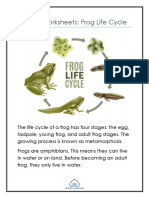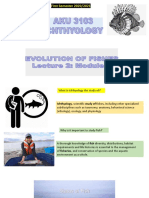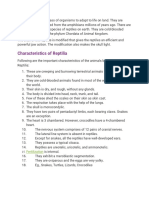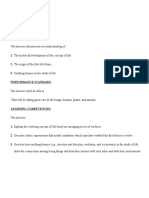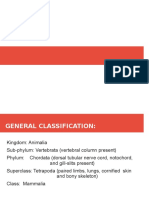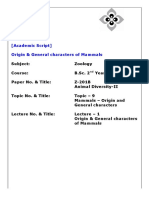Abdi Vertebrate Zoo
Abdi Vertebrate Zoo
Uploaded by
Dennis KipkemoiCopyright:
Available Formats
Abdi Vertebrate Zoo
Abdi Vertebrate Zoo
Uploaded by
Dennis KipkemoiOriginal Title
Copyright
Available Formats
Share this document
Did you find this document useful?
Is this content inappropriate?
Copyright:
Available Formats
Abdi Vertebrate Zoo
Abdi Vertebrate Zoo
Uploaded by
Dennis KipkemoiCopyright:
Available Formats
1) Discuss the general characteristics of vertebrates
(5mks)
Vertebral Column: One of the defining features of vertebrates is their backbone, which
is composed of individual vertebrae stacked on top of each other. This structure provides
support, flexibility, and protection for the spinal cord.
Bilateral Symmetry: Vertebrates typically exhibit bilateral symmetry, meaning their
bodies can be divided into two mirror-image halves along a central axis.
Internal Skeleton: Vertebrates have an internal skeleton made of bone or cartilage. This
skeleton provides support for the body, anchors muscles, and protects internal organs.
Closed Circulatory System: Most vertebrates have a closed circulatory system, where
blood is contained within vessels and pumped by a heart. This system allows for efficient
transport of oxygen, nutrients, and waste products throughout the body.
Advanced Nervous System: Vertebrates have a well-developed nervous system,
including a brain enclosed within a protective skull. They typically have complex sensory
organs, such as eyes, ears, and a well-developed sense of touch.
Endoskeleton: Vertebrates possess an endoskeleton, meaning their skeletal structure is
located internally. This provides greater protection and support compared to exoskeletons
found in some invertebrates.
Vertebrate Groups: Vertebrates encompass a wide range of animals, including fish,
amphibians, reptiles, birds, and mammals. Each group has its own unique characteristics
and adaptations to different environments.
Homeothermy or Heterothermy: Many vertebrates are capable of regulating their body
temperature. Some, like mammals and birds, are endothermic (homeothermic), meaning
they can maintain a relatively constant internal temperature regardless of external
conditions. Others, like reptiles and amphibians, are ectothermic (heterothermic),
meaning their body temperature fluctuates with the temperature of their environment.
Respiratory System: Vertebrates have a variety of respiratory organs and mechanisms,
including lungs, gills, and skin respiration, adapted to their specific habitats and
lifestyles.
Reproduction: Vertebrates reproduce sexually, with well-developed reproductive
organs. Many species exhibit internal fertilization, although there are exceptions, such as
most fish, which typically fertilize eggs externally.
2) Explain the evolution of Chordates
(10mks)
Chordates are a type of animal subcategory or phylum that includes all vertebrates, including
humans, and many non-vertebrates as well. Learn the features and evolution of chordates to
include craniates, vertebrates, jaws, lungs, limbs, and tetrapods, and amniotes.
Evolution of Chordates
The fossil record of chordates begins in the early Cambrian period, roughly 530 million years
ago. The oldest known chordate fossil was found in China and described in 1995. It is a member
of the species Yunnanozoon lividium, within the subphylum Cephalochordata. The earliest
fossil evidence for members of the vertebrate subphylum also dates back roughly 530 million
years. This is when fossils of the jawless fish first appeared.
The earliest tetrapods (having four legs) are the amphibians, with fossils dating back to the
Devonian period, roughly 363 million years ago. Shortly thereafter, reptile-like tetrapods arose.
It was some time after the appearance of reptiles, approximately 80 million years,
that mammals entered the scene. The first mammalian fossils date back to the Triassic period,
about 208 million years ago. Finally, bird fossils appear 146 million years ago in the Jurassic
period.
Chordate evolution, like that of arthropods, includes major habitat transitions. The earliest
chordates were all marine animals like tunicates and lancelets. As chordates continued to
evolve, they spread to freshwater habitats and ultimately to land. The amphibians represent an
intermediate phase in the water to land transition of chordates. The evolution of birds further
increased the distribution of chordates by expanding their populations into aerial habitats.
overview of the evolution of chordates
1. Pre-Chordate Ancestors (Ediacaran Period - Cambrian Explosion)
The origins of chordates can be traced back to the late Ediacaran period and the
Cambrian explosion (around 540-485 million years ago).
Fossil evidence suggests that chordates evolved from a group of primitive marine
organisms known as deuterostomes, which also gave rise to echinoderms (like
starfish and sea urchins) and hemichordates (like acorn worms).
Early chordate ancestors likely resembled small, worm-like organisms that lived
in marine environments.
2. First Chordates (Early Cambrian)
The earliest known chordates appeared in the early Cambrian period, around 525
million years ago.
These early chordates, such as Pikaia, were small, fish-like organisms with a
notochord and other basic chordate characteristics.
They were likely bottom-dwelling filter feeders, using their notochord for support
and movement.
3. Diversification and Adaptation (Ordovician - Devonian)
Throughout the Ordovician, Silurian, and Devonian periods (485-358 million
years ago), chordates underwent significant diversification and adaptation.
Jawless fish, such as the ostracoderms, emerged during this time. These primitive
fish lacked true jaws and paired fins but possessed other chordate features.
By the late Devonian, jawed fish (gnathostomes) had evolved, leading to further
diversification and the emergence of early sharks and bony fish.
4. Transition to Land (Devonian)
One of the most significant milestones in chordate evolution was the transition
from water to land, which occurred during the Devonian period (around 416-359
million years ago).
Tetrapods, the first vertebrates to colonize land, evolved from lobe-finned fish,
such as Eusthenopteron and Tiktaalik. These early tetrapods had limbs with digits
and specialized respiratory adaptations for terrestrial life.
5. Radiation of Amniotes (Carboniferous - Permian):
During the Carboniferous and Permian periods (359-252 million years ago), amniotes, a
group of vertebrates characterized by their ability to lay eggs with membranes that
protect the embryo (amniotic eggs), underwent a significant radiation.
Amniotes include reptiles, birds, and mammals, all of which evolved from early
tetrapods. Reptiles became the dominant land vertebrates during this time, diversifying
into various forms adapted to different environments.
6. Radiation of Terrestrial Vertebrates (Carboniferous to Present):
Following the colonization of land, vertebrates underwent a remarkable radiation, giving
rise to diverse groups adapted to various terrestrial habitats.
This radiation led to the emergence of reptiles, birds, mammals, and other terrestrial
vertebrates, each with unique adaptations for survival in their respective environments.
Reference
Aouacheria, A., C. Cluzel, C. Lethias, M.
Gouy, R. Garrone, and
J.-Y. Exposito. 2004. Invertebrate data
predict an early emer-
gence of vertebrate fibrillar collagen clades
and an anti-incest
model. J. Biol. Chem. 279:47711–47719.
Aouacheria, A., C. Cluzel, C. Lethias, M. Gouy, R. Garrone, andJ.-Y. Exposito. 2004.
Invertebrate data predict an early emer-gence of vertebrate fibrillar collagen clades and an
anti-incestmodel. J. Biol. Chem. 279:47711–47719.
Blair, J. E., and S. B. Hedges, 2005. Molecular phylogeny anddivergence times of
deuterostome animals. Mol. Biol. Evol.22:2275–2284
Burdon-Jones, C. 1952. Development and biology of larva of Sac-coglossus horsti
(Enteropneusta). Phil. Trans. R. Soc. Lond. B236:553–590.485
Cameron, C. B. 2002. The anatomy, life habits, and later devel-opment of a new species
of enteropneust, Harrimania plank-tophilus (Hemichordata: Harrimaniidae) from Barkley
Sound.Biol. Bull. 202:182–19
Yasuo, H., and N. Satoh. 1993. Function of the vertebrate T gene.Nature 364:582–583
Blair, J. E., and S. B. Hedges, 2005.
Molecular phylogeny and
divergence times of deuterostome animals.
Mol. Biol. Evol.
22:2275–2284
Blair, J. E., and S. B. Hedges, 2005. Molecular phylogeny anddivergence times of deuterostome
animals. Mol. Biol. Evol.22:2275–2284
You might also like
- America A Narrative History Brief 11th Edition (Vol. Volume 2) by David Emory Shi David Emory Shi 2024 scribd downloadDocument24 pagesAmerica A Narrative History Brief 11th Edition (Vol. Volume 2) by David Emory Shi David Emory Shi 2024 scribd downloadbondercimel100% (2)
- An Excerpt From "Skin of The Sea" by Natasha Bowen.Document3 pagesAn Excerpt From "Skin of The Sea" by Natasha Bowen.OnPointRadioNo ratings yet
- Frog Cycle PDFDocument6 pagesFrog Cycle PDFEdwin Armando Trujillo AmayaNo ratings yet
- Dolphin Grade 2 Comprehension WorksheetDocument2 pagesDolphin Grade 2 Comprehension WorksheetSaquib.MahmoodNo ratings yet
- Vertebrate AnimalsDocument2 pagesVertebrate Animalsmusamugabazi68No ratings yet
- Vertebrate DiversityDocument14 pagesVertebrate DiversityKacang PeasNo ratings yet
- First Semester 2020/2021Document53 pagesFirst Semester 2020/2021low luffecussNo ratings yet
- The Evolutionary History of The AnimalDocument52 pagesThe Evolutionary History of The AnimalNova Balones NaolNo ratings yet
- Arthropods: Caren Bless A. Alvero Grade 5 - PeaceDocument1 pageArthropods: Caren Bless A. Alvero Grade 5 - PeaceJustin Arga ImportaNo ratings yet
- Reptiles OriginEvolutionDocument11 pagesReptiles OriginEvolution23mzg004No ratings yet
- Life and Role of Primitive Vertebrate: The Guide Lecture: Dr. Safrida, S. PD., M. SiDocument23 pagesLife and Role of Primitive Vertebrate: The Guide Lecture: Dr. Safrida, S. PD., M. SiGina anggrianaNo ratings yet
- Reptiles OriginEvolutionDocument11 pagesReptiles OriginEvolutionPascoal MiguelNo ratings yet
- Vertebrate Zoology HI-1Document383 pagesVertebrate Zoology HI-1tarkulamisoNo ratings yet
- Reptiles OriginEvolutionDocument11 pagesReptiles OriginEvolutionSeptianisa UlfalahNo ratings yet
- Osteichthyes Dan ChondricthyesDocument8 pagesOsteichthyes Dan ChondricthyesAnief wisnuNo ratings yet
- EvolutionDocument4 pagesEvolutionChaudhry AzeemNo ratings yet
- Vertebrate Fossils-ADocument12 pagesVertebrate Fossils-Arupkishor189No ratings yet
- Chapter 3_Phylum ArthropodaDocument43 pagesChapter 3_Phylum Arthropodadeltablack2579No ratings yet
- Characteristics of Reptilia: FertilizationDocument7 pagesCharacteristics of Reptilia: FertilizationTiffy Mariam JohnNo ratings yet
- Chordata NotesDocument5 pagesChordata NotesAbhishek Isaac MathewNo ratings yet
- 1vertebrate Characteristics 2020 PDFDocument5 pages1vertebrate Characteristics 2020 PDFhmin1805No ratings yet
- Introduction of Biology (Group 4)Document11 pagesIntroduction of Biology (Group 4)Shenon Lou M. RevesencioNo ratings yet
- DogsDocument1 pageDogsEqerem IsallariNo ratings yet
- EvolutionDocument88 pagesEvolutionKatelyn ValeraNo ratings yet
- Origin of MammalsDocument26 pagesOrigin of Mammalsjai kumarNo ratings yet
- Identification of Vertebrate Taxonomic CharacterDocument8 pagesIdentification of Vertebrate Taxonomic CharacterFitria RamadhaniNo ratings yet
- Asdherwetertert 123Document20 pagesAsdherwetertert 123Zsombik IstvánNo ratings yet
- Comparative Vertebrate Anatomy Lecture 1Document76 pagesComparative Vertebrate Anatomy Lecture 1Mielah Ruth100% (1)
- Evolution PPTDocument88 pagesEvolution PPTShallaine VernNo ratings yet
- Vertebrate ClassificationDocument5 pagesVertebrate Classificationaneesh sebastianNo ratings yet
- Bio 111-1Document13 pagesBio 111-1efep478No ratings yet
- Evolution of Life On EarthDocument18 pagesEvolution of Life On Earthfrancisjohn echemaniNo ratings yet
- A Research On AnimalsDocument4 pagesA Research On Animalsvacationsonwheels1No ratings yet
- EvolutionDocument94 pagesEvolutionFrance Jhemilee MarcelinoNo ratings yet
- Dipleura CoceptDocument6 pagesDipleura Coceptsdv393No ratings yet
- Iv Unit BiodasDocument14 pagesIv Unit BiodasCokroNo ratings yet
- Classifying Animals into Vertebrates and Invertebrates - Animal Book for 8 Year Olds | Children's Animal BooksFrom EverandClassifying Animals into Vertebrates and Invertebrates - Animal Book for 8 Year Olds | Children's Animal BooksNo ratings yet
- Lmost 45Document1 pageLmost 45Sherilyn ApostolNo ratings yet
- Notes For BiologyDocument13 pagesNotes For Biologyowogorga1No ratings yet
- (Academic Script) Origin & General Characters of MammalsDocument13 pages(Academic Script) Origin & General Characters of MammalsAnkeet KumarNo ratings yet
- Evolution of MammalsDocument27 pagesEvolution of MammalsuzumakitobiNo ratings yet
- Wa0005.Document6 pagesWa0005.kannansk767No ratings yet
- Etymology: Vertebrates (Document65 pagesEtymology: Vertebrates (innaNo ratings yet
- Lecture 17 Notes 2013Document5 pagesLecture 17 Notes 2013Richard HampsonNo ratings yet
- En Wikipedia Org w...Document22 pagesEn Wikipedia Org w...bopasij145No ratings yet
- BiologyDocument4 pagesBiologySara MaldonadoNo ratings yet
- Killer WhaleDocument6 pagesKiller WhaleFase BakNo ratings yet
- Evolution of InsectsDocument6 pagesEvolution of Insectsusman abdulkarimNo ratings yet
- Activity 2Document4 pagesActivity 2Leopoldo ConstantinoNo ratings yet
- Invertebrates Chordata VertebratesDocument62 pagesInvertebrates Chordata VertebratesDao Ming SiNo ratings yet
- Evolution and Fish ClassificationDocument12 pagesEvolution and Fish Classificationlajola.gershon100% (1)
- 379149900lecture 1Document12 pages379149900lecture 1Narender ThakurNo ratings yet
- Phylum ChordataDocument25 pagesPhylum ChordataNicole100% (1)
- MONOGRAPH Vertebrate AnimalsDocument22 pagesMONOGRAPH Vertebrate AnimalsScribdTranslationsNo ratings yet
- Vertebrate PalaeontologyDocument6 pagesVertebrate Palaeontologyosloline4No ratings yet
- Group 2: (Phylum Arthropoda) Group MembersDocument15 pagesGroup 2: (Phylum Arthropoda) Group MembersMae OlitanNo ratings yet
- Paleontology GlossaryDocument24 pagesPaleontology GlossarycurlyfriezNo ratings yet
- Biological Systems Module 6.2Document4 pagesBiological Systems Module 6.2xara zinkNo ratings yet
- Lab ArtropodeDocument15 pagesLab ArtropodeVonna IonescuNo ratings yet
- General BiologyDocument10 pagesGeneral Biologypascuavergel3No ratings yet
- PHYLUM MOLLUSCA Final-1Document36 pagesPHYLUM MOLLUSCA Final-1carpel170No ratings yet
- Evolution Unit-5Document30 pagesEvolution Unit-5sakthivel M I zoologyNo ratings yet
- The Dangerous Book of Dinosaurs: Are You Ready to Come Face-to-Face with a T-Rex?From EverandThe Dangerous Book of Dinosaurs: Are You Ready to Come Face-to-Face with a T-Rex?No ratings yet
- Deep Thinkers: Inside the Minds of Whales, Dolphins, and PorpoisesFrom EverandDeep Thinkers: Inside the Minds of Whales, Dolphins, and PorpoisesNo ratings yet
- Ntsa Strategic Plan 2023-2027 Validation Workshop ReportDocument11 pagesNtsa Strategic Plan 2023-2027 Validation Workshop ReportDennis Kipkemoi100% (1)
- Emotional Developmental ChangesDocument7 pagesEmotional Developmental ChangesDennis KipkemoiNo ratings yet
- Risk ManagementDocument4 pagesRisk ManagementDennis KipkemoiNo ratings yet
- Project AssignmentDocument7 pagesProject AssignmentDennis KipkemoiNo ratings yet
- List of National AnimalsDocument36 pagesList of National Animalspai_serg100% (1)
- D100 - NightmaresDocument1 pageD100 - NightmaresCésar FernándezNo ratings yet
- Just So Stories by Rudyard KiplingDocument66 pagesJust So Stories by Rudyard KiplingMirela DiaconescuNo ratings yet
- 02 113學測英文科試題Document12 pages02 113學測英文科試題Elvira LuNo ratings yet
- Kingdom CompilationDocument79 pagesKingdom CompilationPrayl Hope NapanoNo ratings yet
- Respuestas de Los EjerciciosDocument59 pagesRespuestas de Los EjerciciosPaula JoglarNo ratings yet
- Nature Guide - BirdsDocument354 pagesNature Guide - BirdsimalettinNo ratings yet
- Azoo Taiwan June List STDDocument132 pagesAzoo Taiwan June List STDtruck449publicNo ratings yet
- Zeeberg Et Al 2006 #Bycatch and Release in Trawler FisheriesDocument10 pagesZeeberg Et Al 2006 #Bycatch and Release in Trawler FisheriesTjahjo Tri HartonoNo ratings yet
- DRY INGLES 2020 - Guia de EstudiosDocument47 pagesDRY INGLES 2020 - Guia de EstudiosFigueredo Juan MartinNo ratings yet
- Kiem Tra 1 Tiet Tieng Anh 10 Hoc Ky 2 (U12-13)Document4 pagesKiem Tra 1 Tiet Tieng Anh 10 Hoc Ky 2 (U12-13)LocNguyenNo ratings yet
- Grade 5 Unit 7 Achievement TestDocument2 pagesGrade 5 Unit 7 Achievement TestMr. Ahmed M. HassanNo ratings yet
- Fishery Arts Fishery Arts: Mrs. Sally C. SaldeDocument28 pagesFishery Arts Fishery Arts: Mrs. Sally C. SaldeJered Morato100% (1)
- Reteach 4Document97 pagesReteach 4Spring BballNo ratings yet
- Jenis IkanDocument17 pagesJenis IkanTalk 2meNo ratings yet
- Perpetuaion of Life - How Animals ReproduceDocument3 pagesPerpetuaion of Life - How Animals ReproduceBenjamin Fernandez Jr.No ratings yet
- Basic 1a Uts English Term 2 24Document6 pagesBasic 1a Uts English Term 2 24John JoNo ratings yet
- Analogy Answer KeyDocument8 pagesAnalogy Answer KeyKesava MirthipatiNo ratings yet
- Fish Spa CostingDocument8 pagesFish Spa CostingAkshaya LakshminarasimhanNo ratings yet
- Lesson Plan in Kench SaltingDocument8 pagesLesson Plan in Kench SaltingFLORDELONA CAYANo ratings yet
- English 5 Q2 Module 1Document24 pagesEnglish 5 Q2 Module 1Cantina, Jasmin P.No ratings yet
- (53 - 75) 1.2. Animal Kingdom (OBJ)Document23 pages(53 - 75) 1.2. Animal Kingdom (OBJ)Mayuri chatpalliwarNo ratings yet
- JHON Lesson 6 AFADocument4 pagesJHON Lesson 6 AFAJHON ANDREI SEMANo ratings yet
- DolphinDocument37 pagesDolphinalamingazi6381No ratings yet
- (DK Eyewitness Books) Colin McCarthy - Eyewitness - Reptile - DK CHILDREN (2000)Document65 pages(DK Eyewitness Books) Colin McCarthy - Eyewitness - Reptile - DK CHILDREN (2000)C同学No ratings yet
- Body Forms of FishesDocument12 pagesBody Forms of Fishesrano khanNo ratings yet


